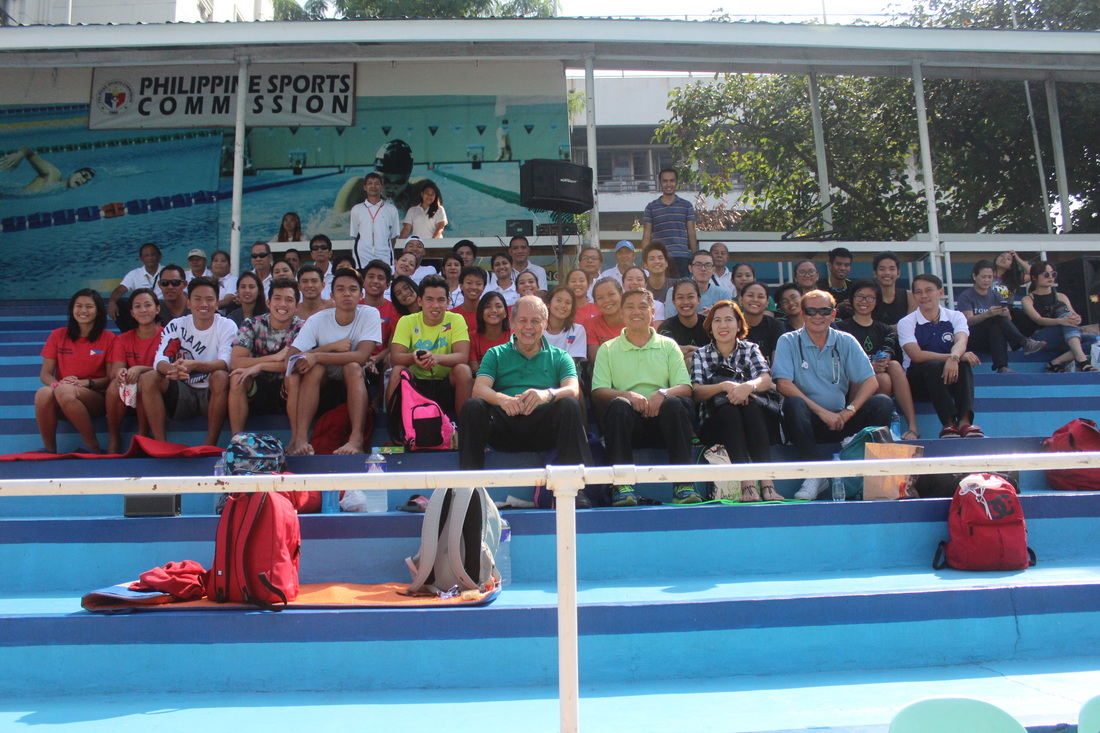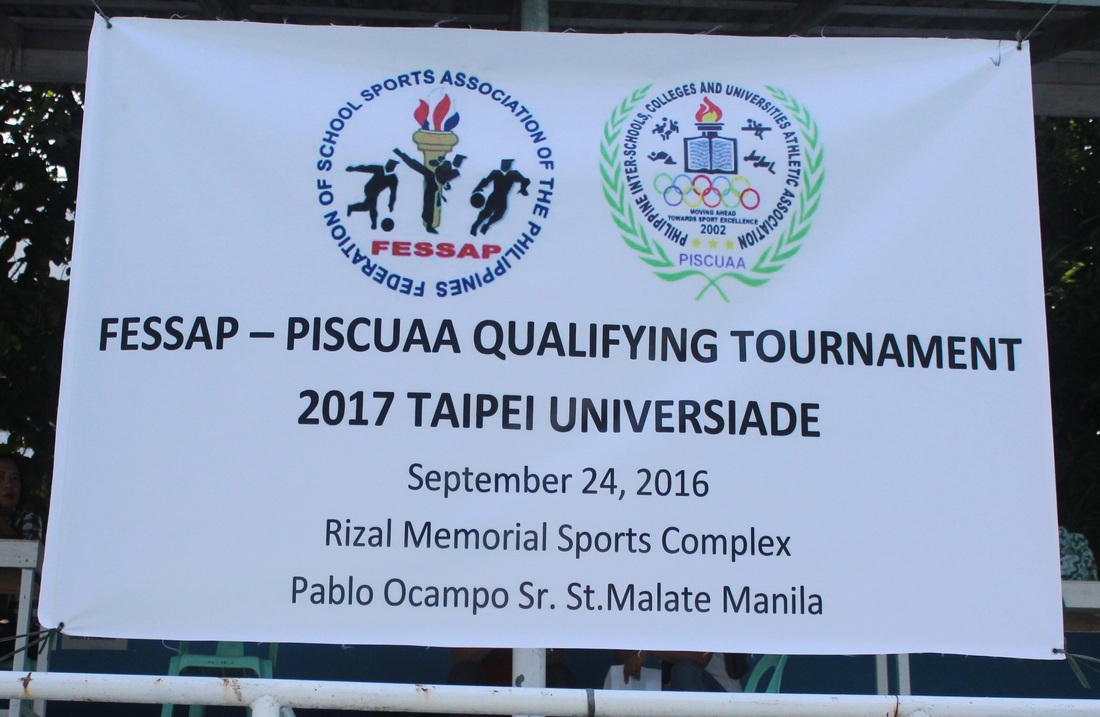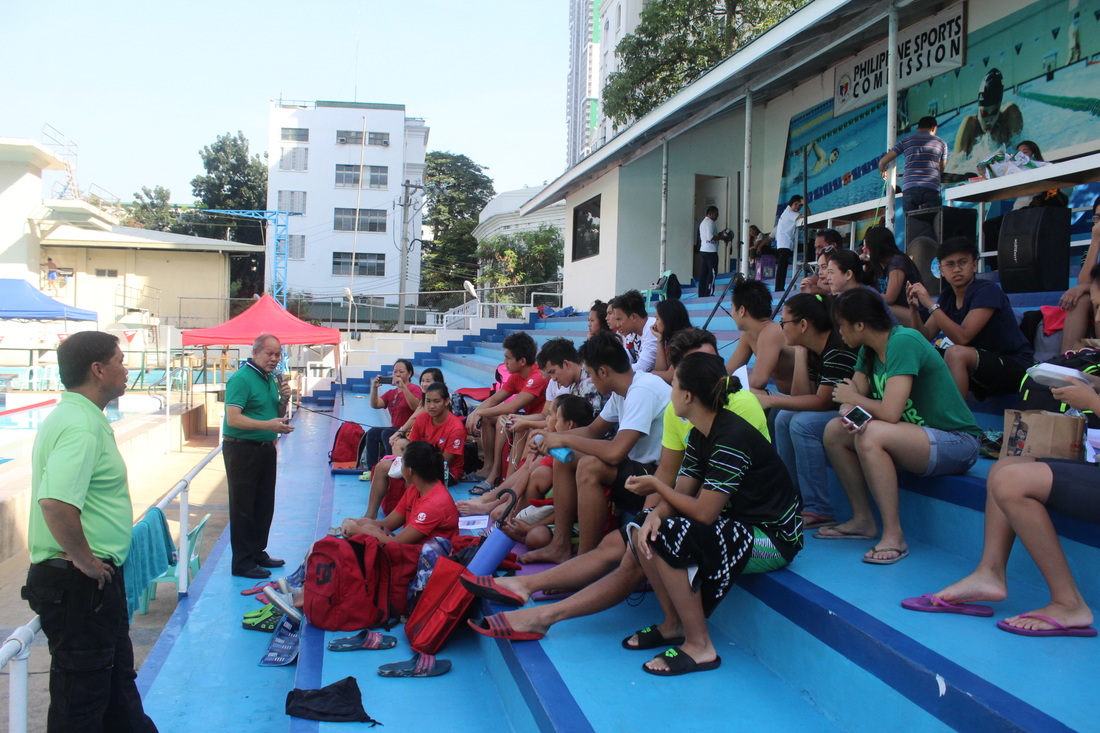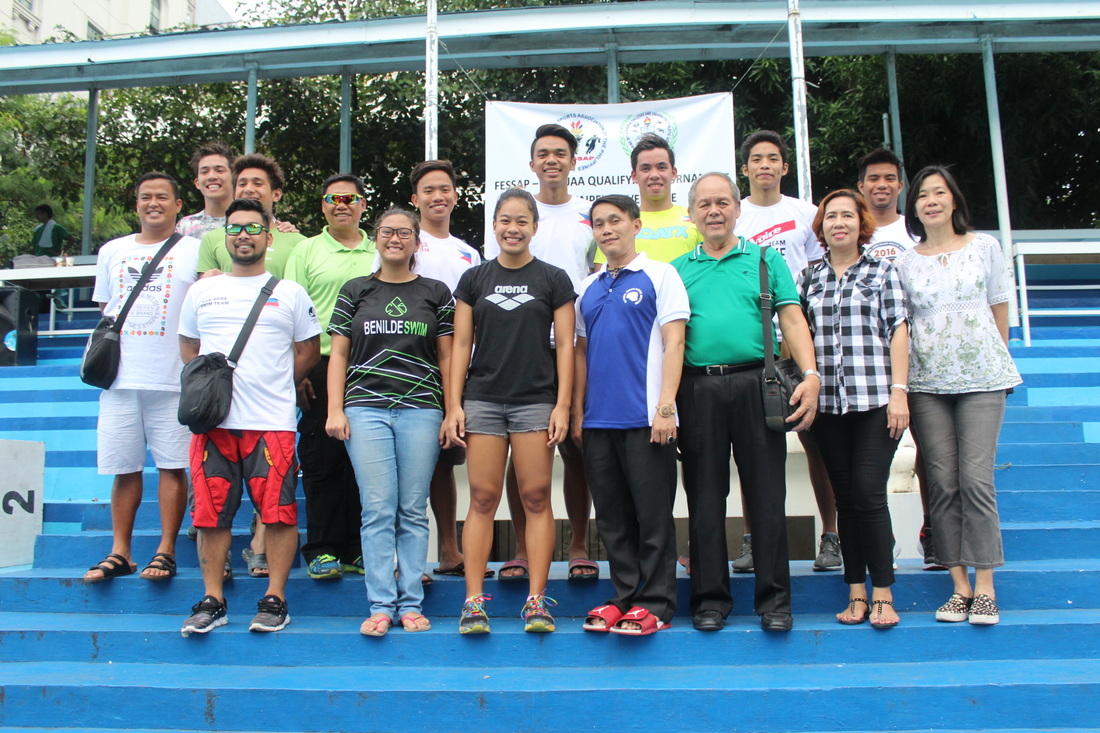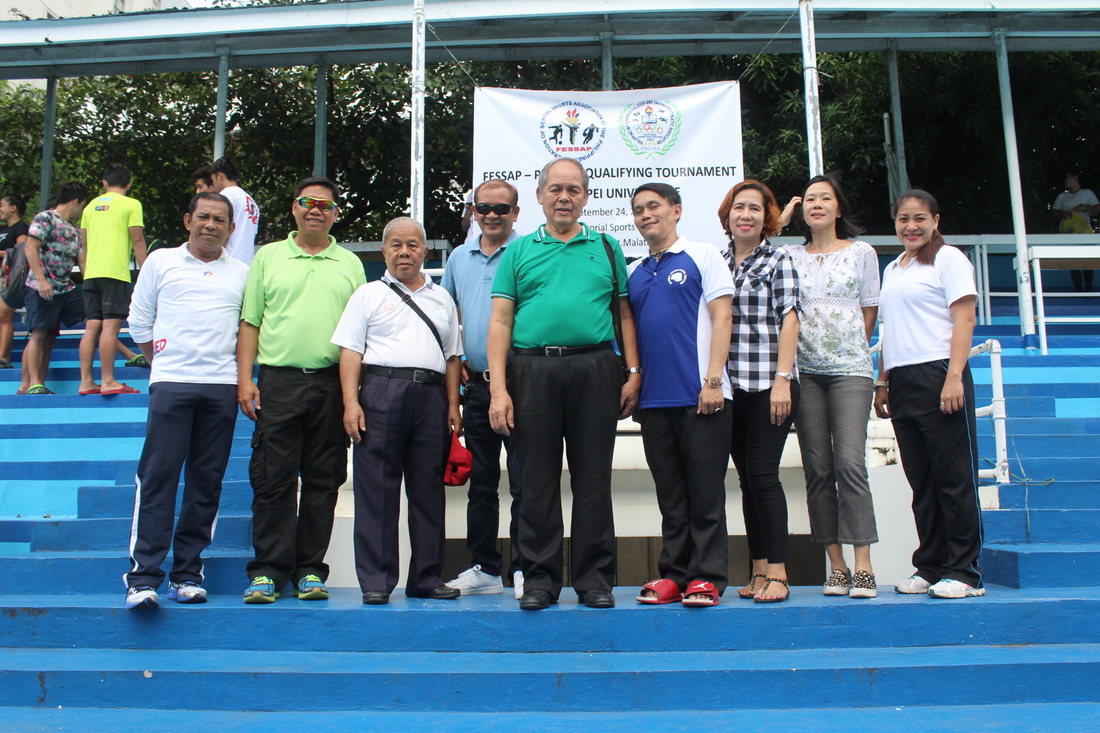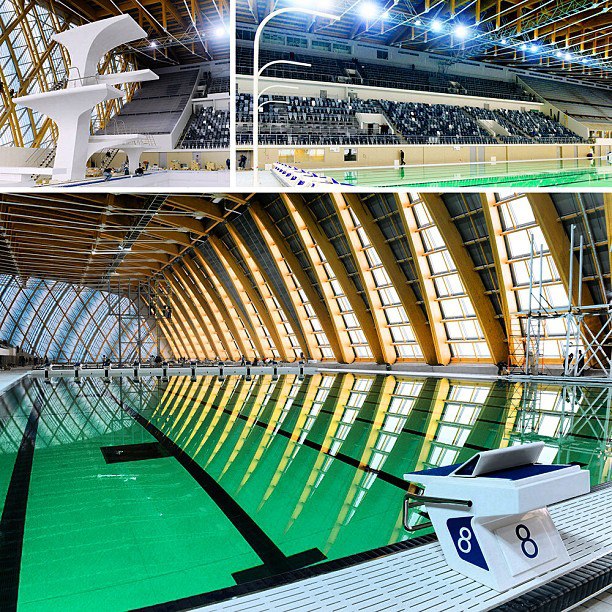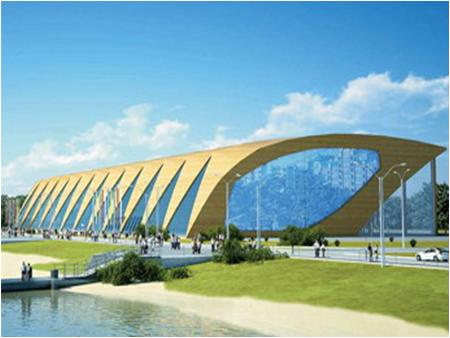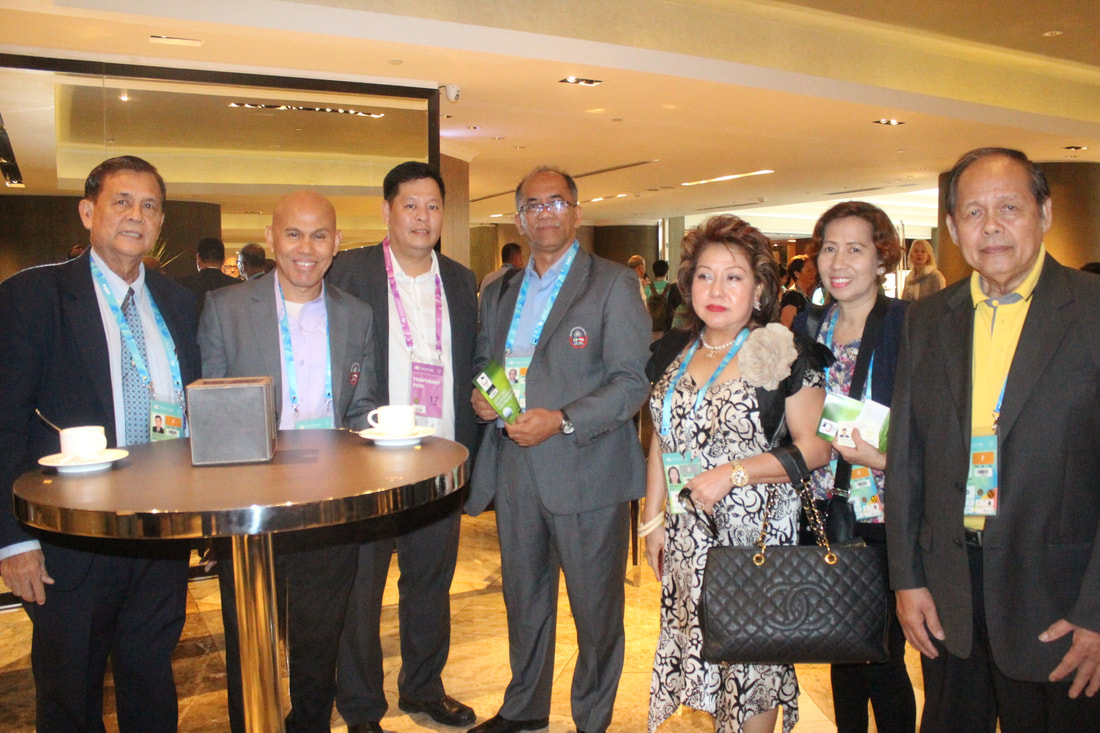 Federation of School Sports Association of the Philippines (FESSAP) will host the first-ever Asia Pacific University Swimming Championship on April 13-15, 2018. Photo shows (fromleft to right) FESSAP vice-president Atty. Baldomero Estenzo, Prof. Dato' Dr. Abdullah Mohamad Said, FESSAP president David Ong, APUSU secretary-general Mustaza Ahmad, Atty. Maria Luz Arzaga-Mendoza, Cecille Sarmiento and Prof. Robert Milton Calo during the FISU General Assembly in Taipei City.
Federation of School Sports Association of the Philippines (FESSAP) will host the first-ever Asia Pacific University Swimming Championship on April 13-15, 2018. Photo shows (fromleft to right) FESSAP vice-president Atty. Baldomero Estenzo, Prof. Dato' Dr. Abdullah Mohamad Said, FESSAP president David Ong, APUSU secretary-general Mustaza Ahmad, Atty. Maria Luz Arzaga-Mendoza, Cecille Sarmiento and Prof. Robert Milton Calo during the FISU General Assembly in Taipei City.
FESSAP to host AsPac swimfest
By: Graham C. Lim, People's Tonight (Sports Editor: Ed Andaya) September 23, 2017
IT’S FINAL.
The first-ever Asia Pacific University Swimming Championship will be held as scheduled in the Philippines on April 13-15, 2018.
Venues being considered for the three-day competitions sanctioned by the Federation of School Sports Association of the Philippines (FESSAP) and the Asia Pacific University Sports Union (APUSU) include Iloilo City or the province of Pampanga.
FESSAP executive vice president, Robert Milton Calo of PISCUAA said that the FESSAP Aquatic Club will be tapped to supervise the preparations for the swimming championship.
Aside from Prof. Calo, the other members of the FESSAP Aquatic Club working committee are Allan Soria of the SCUAA, Ivy Sta. Ana of PRISAA, Edgar Galeno, Jim Justin Jalseburge Ang, Emer Matienzo, and Dennis Antonio Cordero.
The FESSAP Aquatic Club will soon coordinate with various local government units to present its project.
Among the countries invited to participate in the first-ever Asia Pacific University Swimming Championship include Malaysia, Australia, Japan, Taiwan, Papua New Guinea, and the Republic of Korea.
Meanwhile, the 2nd Asia Pacific University Games (APUG) will be held in Cebu City on Dec. 6-11 this year.
The University of Cebu (UC) will host the multi-sport festivities.
Atty. Baldomero Estenzo, the UC Dean of Law, is the Organizing Committee Chair of the 2nd APUG event.
Atty. Estenzo has been appointed by the Asia Pacific University Sports Union (APUSU) Board to manage the APUG games along with Prof. Mustaza Ahmad, the APUSU secretary general from Malaysia.
Prof. Mustaza is also currently the secretary-general of the Malaysia University Sports Federation or MASUM, a member of FISU.
By: Graham C. Lim, People's Tonight (Sports Editor: Ed Andaya) September 23, 2017
IT’S FINAL.
The first-ever Asia Pacific University Swimming Championship will be held as scheduled in the Philippines on April 13-15, 2018.
Venues being considered for the three-day competitions sanctioned by the Federation of School Sports Association of the Philippines (FESSAP) and the Asia Pacific University Sports Union (APUSU) include Iloilo City or the province of Pampanga.
FESSAP executive vice president, Robert Milton Calo of PISCUAA said that the FESSAP Aquatic Club will be tapped to supervise the preparations for the swimming championship.
Aside from Prof. Calo, the other members of the FESSAP Aquatic Club working committee are Allan Soria of the SCUAA, Ivy Sta. Ana of PRISAA, Edgar Galeno, Jim Justin Jalseburge Ang, Emer Matienzo, and Dennis Antonio Cordero.
The FESSAP Aquatic Club will soon coordinate with various local government units to present its project.
Among the countries invited to participate in the first-ever Asia Pacific University Swimming Championship include Malaysia, Australia, Japan, Taiwan, Papua New Guinea, and the Republic of Korea.
Meanwhile, the 2nd Asia Pacific University Games (APUG) will be held in Cebu City on Dec. 6-11 this year.
The University of Cebu (UC) will host the multi-sport festivities.
Atty. Baldomero Estenzo, the UC Dean of Law, is the Organizing Committee Chair of the 2nd APUG event.
Atty. Estenzo has been appointed by the Asia Pacific University Sports Union (APUSU) Board to manage the APUG games along with Prof. Mustaza Ahmad, the APUSU secretary general from Malaysia.
Prof. Mustaza is also currently the secretary-general of the Malaysia University Sports Federation or MASUM, a member of FISU.
September 24, 2016 (Saturday) Rizal Memorial Swimming Pool
FESSAP THROUGH ITS MEMBER, PISCUAA, TO SUPERVISE SWIMMING QUALIFYING TOURNAMENT TODAY TO 2017 TAIPEI UNIVERSIADE
Philippine Inter-Schools, Colleges & Universities Athletic Association (PISCUAA) will conduct today (September 24) swimming qualifying tryouts and rankings of the swimmers that will compete in the Summer Universiade in Taipei City, Taiwan in August next year.
Present invited to witness on hand are Retired Col. Ariel Querubin, FESSAP deputy secretary general and Universiade Overall Team Manager; Dr. Diosdado Amante, FESSAP Vice President; and Prof. Robert Milton Calo, FESSAP Executive Vice President as Chair of the Taipei Universiade's Preparation and Monitoring Committee.
PISCUAA, in cooperation with other accredited clubs and league, has been authorized by FESSAP to conduct the swimming qualifying tournament to the Taipei Universiade.
Last Sept 17-18, the FESSAP allowed the PISCUAA to hold first qualifying meet. It was attended by no more than 16 swimmers – a few of which were selected based on their ranking and clocking standards imposed by the FESSAP.
The Working Committee is still evaluating the results of the first qualifier.
The next qualifying tournament for today, to be conducted by Prof. Calo, is set today (September 24), beginning 7:00 a.m., at the Philippine Sports Commission-run Rizal Memorial swimming pool along Vito Cruz, Manila.
Student-athletes from FESSAP-accredited clubs or leagues are most welcome to join the tryout at the Rizal Memorial swimming pool. The PSC has graciously granted the FESSAP the free use of the pool for its Universiade qualifying tournaments in the National Capital region.
The third qualifying event will be held in Iloilo City next month under the supervision of the FESSAP-accredited club headed by Ivy Santa Ana. Top swimmers from the Visayas region are enjoined to come to Iloilo City for the qualifier.
The FESSAP then will invite the swimmers that have met the ranking standards set by the FESSAP Board to see action in the Taipei Universiade.
The final qualifying tryouts will be held in Tagum, Zamboanga under the supervision of FESSAP Board member Roel Natividad Sr. in November 2016.
The PISCUAA Swimming Working Committee shall evaluate the results of all the Universiade qualifying meets before submitting its recommendation to the entire FESSAP Board for final approval.
We look forward to a better performance from the top-ranking swimmers from around the country as the FESSAP prepares its lineup of student-athletes to the multi-sport Taipei Universiade.
The entry fee in the qualifying tournaments is subject for approval by the FESSAP.
FESSAP has also inform PISCUAA and other clubs/league regarding any unauthorized usage of FESSAP logo unless written consent is obtain.
NOTE:
One of the basic qualifying rules is a student-athletes that won in the qualifying tournament (ranking imposed) and are sent to the 2017 Summer Universiade in Taipei upon the approval of the FESSAP are obligated to shoulder the following expenses:
a. Roundtrip Airfare for Manila to Taipei to Manila;
b. Universiade Participation Fee (which include food and room accommodations in the Athletes Village) costing around 10
Euros (or its equivalent in American US dollars) per day per athlete/person;
c. One-time payment for FISU Membership Fee of 20 Euros per athlete/person.
FESSAP THROUGH ITS MEMBER, PISCUAA, TO SUPERVISE SWIMMING QUALIFYING TOURNAMENT TODAY TO 2017 TAIPEI UNIVERSIADE
Philippine Inter-Schools, Colleges & Universities Athletic Association (PISCUAA) will conduct today (September 24) swimming qualifying tryouts and rankings of the swimmers that will compete in the Summer Universiade in Taipei City, Taiwan in August next year.
Present invited to witness on hand are Retired Col. Ariel Querubin, FESSAP deputy secretary general and Universiade Overall Team Manager; Dr. Diosdado Amante, FESSAP Vice President; and Prof. Robert Milton Calo, FESSAP Executive Vice President as Chair of the Taipei Universiade's Preparation and Monitoring Committee.
PISCUAA, in cooperation with other accredited clubs and league, has been authorized by FESSAP to conduct the swimming qualifying tournament to the Taipei Universiade.
Last Sept 17-18, the FESSAP allowed the PISCUAA to hold first qualifying meet. It was attended by no more than 16 swimmers – a few of which were selected based on their ranking and clocking standards imposed by the FESSAP.
The Working Committee is still evaluating the results of the first qualifier.
The next qualifying tournament for today, to be conducted by Prof. Calo, is set today (September 24), beginning 7:00 a.m., at the Philippine Sports Commission-run Rizal Memorial swimming pool along Vito Cruz, Manila.
Student-athletes from FESSAP-accredited clubs or leagues are most welcome to join the tryout at the Rizal Memorial swimming pool. The PSC has graciously granted the FESSAP the free use of the pool for its Universiade qualifying tournaments in the National Capital region.
The third qualifying event will be held in Iloilo City next month under the supervision of the FESSAP-accredited club headed by Ivy Santa Ana. Top swimmers from the Visayas region are enjoined to come to Iloilo City for the qualifier.
The FESSAP then will invite the swimmers that have met the ranking standards set by the FESSAP Board to see action in the Taipei Universiade.
The final qualifying tryouts will be held in Tagum, Zamboanga under the supervision of FESSAP Board member Roel Natividad Sr. in November 2016.
The PISCUAA Swimming Working Committee shall evaluate the results of all the Universiade qualifying meets before submitting its recommendation to the entire FESSAP Board for final approval.
We look forward to a better performance from the top-ranking swimmers from around the country as the FESSAP prepares its lineup of student-athletes to the multi-sport Taipei Universiade.
The entry fee in the qualifying tournaments is subject for approval by the FESSAP.
FESSAP has also inform PISCUAA and other clubs/league regarding any unauthorized usage of FESSAP logo unless written consent is obtain.
NOTE:
One of the basic qualifying rules is a student-athletes that won in the qualifying tournament (ranking imposed) and are sent to the 2017 Summer Universiade in Taipei upon the approval of the FESSAP are obligated to shoulder the following expenses:
a. Roundtrip Airfare for Manila to Taipei to Manila;
b. Universiade Participation Fee (which include food and room accommodations in the Athletes Village) costing around 10
Euros (or its equivalent in American US dollars) per day per athlete/person;
c. One-time payment for FISU Membership Fee of 20 Euros per athlete/person.
FESSAP-PISCUAA SWIMMING QUALIFYING TOURNAMENT
TAIPEI WORLD UNIVERSDIAD
FESSAP-PISCUAA SWIMMING QUALIFYING TOURNAMENT
TAIPEI WORLD UNIVERSDIADE
Rizal Memorial Sports Complex
July 2016
GROUND RULES
1.1. The rules of the FESSAP-PISCUAA Games 2016 and the Swimming Rules of the Federation Internationale de Nation (FINA) will be applied. Ground rules which have been agreed upon shall be implemented.
1.2. In matters not provided for, decisions shall rest with the Technical and/or the Organizing Committee.
1.3 There shall be two (2) division for the FESSAP-PISCUAA Games 2016 Swimming Championship:
1.4. One start rule.
1.5. Competition will be in Timed Finals format.
1.6. Each delegation is allowed to enter two (2) swimmers per individual event and one (1) relay team in the relay events.
1.7. Each swimmer is allowed to swim five (5) individual events and two (2) relay events.
1.8. A swimmer who fails to swim an event will not be allowed to swim his succeeding events for that session unless otherwise for medical reason and that swimmer must submit a medical report from the FESSAP-PISCUAA Games 2016 Official Medical Physician.
1.9. Only athletes, coaches and Delegation Officials with official identification tags will be allowed at areas designated for delegates.
2. RELAY ENTRY
2.1. Four (4) names of swimmers in order of swim for relay team entries including two (2) alternates for Freestyle Relay and four (4) alternates for the Medley Relay must be submitted in the master list of entries.
2.2 Indicate order of swim by numbering swimmers (e.g. 1-6) in the official entry form and seed times.
2.3. Relay order of swimmers one (1) to four (4) only may be changed 30 minutes before the start of the relay competition day.
3. SWIMWEAR
3.1. The swimwear (swimsuit, cap and goggles) of all competitors shall be in good moral taste and suitable for the individual sports disciplines and not to carry any symbol which may be considered offensive.
3.2. All swim suits shall be non-transparent.
3.3. The competitor must wear swimsuit in one or two pieces. For men, the swimsuit shall not extend above the navel nor below the knee and for women, shall not cover the neck, extend past the shoulder, nor extend below the knee. All swimsuits shall be made from textile materials. No additional items, like arm bands or leg bands shall be regarded as parts of a swimsuit.
3.4. The referee of a competition has the authority to exclude any competitor whose swimwear or body symbols do not comply with this Rule.
3.5. Composition/other items: Men’s swimsuits are in one piece. Subject to decency rule and observance of limitation in surface covered, Women’s swimsuits may be in one or two pieces. Other items covering the body and not part of the swimsuit are prohibited.
4. PROTEST
4.1. Protests are possible
4.1.1. If the rules and regulations for the conduct of the competition are not observed,
4.1.2. If other conditions endanger the competitions and/or competitors, or
4.1.3. Against decisions of the referee; however, no protest shall be allowed against decisions of fact.
4.2. Protest must be submitted
4.2.1. To the referee
4.2.2. In writing
4.2.3. By the Official Team Coach only
4.2.4. Together with a deposit of P 5,000.00
4.2.5. Within 30 minutes following the conclusion of the respective event
4.2.6. If the protest is rejected, the deposit shall be forfeited to the organizing committee. If the protest is upheld, the deposit shall be returned.
5. TIMING
5.1. In the case of an error in the electronic timing systems and/or manual timing systems or the Referee declares an electronic timing systems and/or manual timing systems malfunction, official time of a swimmer shall be determined as follows:
5.1.1. A swimmer having neither an Automatic Equipment place nor an Automatic Equipment time shall establish his relative order by the time recorded by the Semi-Automatic Equipment or by the manual digital watch.
5.1.2. If in the case that the official manual time of the first swimmer is higher than the time of the second swimmer, average time of swimmers involved shall be the official time of both swimmers.
5.1.3. In the case of rule 5.1.2., official placing will be decided by the referee based on facts and a referee’s decision (RD or J) will be indicated in the official results.
6. TEAM COMPOSITION
6.1. Number of swimmers per delegation will be as follows:
10 Male and 10 Female for the Senior’s Division
7. SUBMISSION OF ENTRIES
7.1. All entries must be on official entry forms.
7.2. Submission of entries must indicate the latest best time of each swimmer in each event for seeding purposes and lane assignments.
7.3. Entries must be submitted on or before July 31, 2016 Friday at 12:00 P.M., properly filled up and signed. Entries may be submitted emailed
to:
[email protected] cc:[email protected]
cc: [email protected]
7.4. Late entries will not be accepted.
8. Selection for the Most Outstanding Swimmer for Men and Women will be based on the most number of individual gold medals won. If tie exist, breaking of tie will be based on the following:
8.1. most number of individual silver medals won
8.2. if tie still exist, individual bronze medal won.
8.3. if tie still exist, next highest individual placing.
8.4. if tie still exist, both swimmers will be declared Most Outstanding
Swimmers.
9. Coaches and Team Managers’ meeting will be held after the solidarity meeting.
-oOo-
RICHARD G. LUNA
Tournament Director
NOTED:
ROBERT MILTON A. CALO
Organizer
FESSAP-PISCUAA Swimming Qualifying Tournament
TAIPEI WORLD UNIVERSDIADE
Rizal Memorial Sports Complex
July 2016
GROUND RULES
- COMPETITION RULES
1.1. The rules of the FESSAP-PISCUAA Games 2016 and the Swimming Rules of the Federation Internationale de Nation (FINA) will be applied. Ground rules which have been agreed upon shall be implemented.
1.2. In matters not provided for, decisions shall rest with the Technical and/or the Organizing Committee.
1.3 There shall be two (2) division for the FESSAP-PISCUAA Games 2016 Swimming Championship:
- SENIORS Division for college students for Male
1.4. One start rule.
1.5. Competition will be in Timed Finals format.
1.6. Each delegation is allowed to enter two (2) swimmers per individual event and one (1) relay team in the relay events.
1.7. Each swimmer is allowed to swim five (5) individual events and two (2) relay events.
1.8. A swimmer who fails to swim an event will not be allowed to swim his succeeding events for that session unless otherwise for medical reason and that swimmer must submit a medical report from the FESSAP-PISCUAA Games 2016 Official Medical Physician.
1.9. Only athletes, coaches and Delegation Officials with official identification tags will be allowed at areas designated for delegates.
2. RELAY ENTRY
2.1. Four (4) names of swimmers in order of swim for relay team entries including two (2) alternates for Freestyle Relay and four (4) alternates for the Medley Relay must be submitted in the master list of entries.
2.2 Indicate order of swim by numbering swimmers (e.g. 1-6) in the official entry form and seed times.
2.3. Relay order of swimmers one (1) to four (4) only may be changed 30 minutes before the start of the relay competition day.
3. SWIMWEAR
3.1. The swimwear (swimsuit, cap and goggles) of all competitors shall be in good moral taste and suitable for the individual sports disciplines and not to carry any symbol which may be considered offensive.
3.2. All swim suits shall be non-transparent.
3.3. The competitor must wear swimsuit in one or two pieces. For men, the swimsuit shall not extend above the navel nor below the knee and for women, shall not cover the neck, extend past the shoulder, nor extend below the knee. All swimsuits shall be made from textile materials. No additional items, like arm bands or leg bands shall be regarded as parts of a swimsuit.
3.4. The referee of a competition has the authority to exclude any competitor whose swimwear or body symbols do not comply with this Rule.
3.5. Composition/other items: Men’s swimsuits are in one piece. Subject to decency rule and observance of limitation in surface covered, Women’s swimsuits may be in one or two pieces. Other items covering the body and not part of the swimsuit are prohibited.
4. PROTEST
4.1. Protests are possible
4.1.1. If the rules and regulations for the conduct of the competition are not observed,
4.1.2. If other conditions endanger the competitions and/or competitors, or
4.1.3. Against decisions of the referee; however, no protest shall be allowed against decisions of fact.
4.2. Protest must be submitted
4.2.1. To the referee
4.2.2. In writing
4.2.3. By the Official Team Coach only
4.2.4. Together with a deposit of P 5,000.00
4.2.5. Within 30 minutes following the conclusion of the respective event
4.2.6. If the protest is rejected, the deposit shall be forfeited to the organizing committee. If the protest is upheld, the deposit shall be returned.
5. TIMING
5.1. In the case of an error in the electronic timing systems and/or manual timing systems or the Referee declares an electronic timing systems and/or manual timing systems malfunction, official time of a swimmer shall be determined as follows:
5.1.1. A swimmer having neither an Automatic Equipment place nor an Automatic Equipment time shall establish his relative order by the time recorded by the Semi-Automatic Equipment or by the manual digital watch.
5.1.2. If in the case that the official manual time of the first swimmer is higher than the time of the second swimmer, average time of swimmers involved shall be the official time of both swimmers.
5.1.3. In the case of rule 5.1.2., official placing will be decided by the referee based on facts and a referee’s decision (RD or J) will be indicated in the official results.
6. TEAM COMPOSITION
6.1. Number of swimmers per delegation will be as follows:
10 Male and 10 Female for the Senior’s Division
7. SUBMISSION OF ENTRIES
7.1. All entries must be on official entry forms.
7.2. Submission of entries must indicate the latest best time of each swimmer in each event for seeding purposes and lane assignments.
7.3. Entries must be submitted on or before July 31, 2016 Friday at 12:00 P.M., properly filled up and signed. Entries may be submitted emailed
to:
[email protected] cc:[email protected]
cc: [email protected]
7.4. Late entries will not be accepted.
8. Selection for the Most Outstanding Swimmer for Men and Women will be based on the most number of individual gold medals won. If tie exist, breaking of tie will be based on the following:
8.1. most number of individual silver medals won
8.2. if tie still exist, individual bronze medal won.
8.3. if tie still exist, next highest individual placing.
8.4. if tie still exist, both swimmers will be declared Most Outstanding
Swimmers.
9. Coaches and Team Managers’ meeting will be held after the solidarity meeting.
-oOo-
RICHARD G. LUNA
Tournament Director
NOTED:
ROBERT MILTON A. CALO
Organizer
FESSAP-PISCUAA Swimming Qualifying Tournament
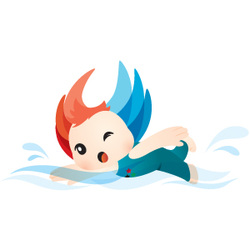
- Swimming in 28th Summer Universiade 2015
- After athletics, swimming has the largest number of events in the Olympics. Swimmers use their hands and feet to move forward in the water in the sport of swimming, which is accessible as a relatively easy-to-learn community sport for people of all ages and genders. Swimming is helpful in developing muscles and maintaining heart and lung health as it requires swimmers to use their whole body and take deep breaths.
Total days of play : 7days
Events
21 men’s events
<Individual events>
Freestyle: 50m, 100m, 200m, 400m, 800m,1500m, 10km open water
Breaststroke: 50m, 100m, 200m
Backstroke: 50m, 100m, 200m
Butterfly: 50m, 100m, 200m
Individual medley: 200m, 400m
<Team relays>
4*100m, 4*200m freestyle relays; 4*100m medley relay
21 women’s events
<Individual events>
Freestyle: 50m, 100m, 200m, 400m, 800m,1500m, 10km open water
Breaststroke: 50m, 100m, 200m
Backstroke: 50m, 100m, 200m
Butterfly: 50m, 100m, 200m
Individual medley: 200m, 400m
<Team relays>
4*100m, 4*200m freestyle relays; 4*100m medley relay
Rules
< Freestyle (crawl) >
Swimmers stretch their bodies into a position that creates less resistance in the water and continuously pull forward with alternate arms while moving each leg up and down in alternating kicks that propel the body forward faster than any other stroke.
< Breaststroke >
Breaststroke can be swum with the face above water in recreational swimming, or with the head coming out of the water only when taking breaths in the much faster version of breaststroke in competitive swimming. While the legs are spread wider in recreational breaststroke in order to keep the body afloat, competitive breaststroke requires arms and legs to be kept closer to the body to allow faster forward movement.
< Backstroke >
The face of the swimmer remains above the water in backstroke, which is swum on one’s back. Since breathing is not a problem in the backstroke position, it may be helpful for people who find it impossible to take breaths while swimming (and people who cannot bear putting their face underwater) to learn backstroke first.
< Butterfly >
Like the front crawl, swimmers stretch out face down and move their arms and legs in the water, only in this case, the movement of arms and legs must be symmetrical. Through up-and-down movements in the water, the swimmer is propelled forward with every pull and every kick. This is usually the fastest stroke after the front crawl.
< Medley >
Butterfly à backstroke à breaststroke à freestyle
History
Swimming dates far back into history in both the East and the West, but due to the absence of accurate historical records, the origin of this sport remains unknown. Swimming most likely dates back to prehistoric ages and was probably practiced from the earliest days in the history of human beings. Prehistoric men who lived by the sea or a river must have had to swim for food in the water or swim across rivers and streams to move to new areas. These prehistoric men may also probably have been forced to dive underwater and jump off cliffs while trying to escape from predators.
Swimmers are depicted in stone sculptures that date back to 1000 B.C., and ancient records tell us of underwater combats and underwater workers. It is quite likely that the history of swimming goes all the way back to the prehistoric ages
Swimming was included in the first modern Olympics held in 1896 during which 100m, 500m and 1,200m freestyle events were held, and swimming has been an official discipline of the Olympic Games since the second Olympics held in 1900 in Paris.
Facilities- New Construction Swimming Pool
~~~~~~~~~~~~~~~~~~~~~~~~~~~~~~~~~~~~~~~~~~~~~~~~~~~~~~~~~~~~~~~~~~~~~~~~~~~~~~~~~~~~~~~~~~~~~
21 men’s events
<Individual events>
Freestyle: 50m, 100m, 200m, 400m, 800m,1500m, 10km open water
Breaststroke: 50m, 100m, 200m
Backstroke: 50m, 100m, 200m
Butterfly: 50m, 100m, 200m
Individual medley: 200m, 400m
<Team relays>
4*100m, 4*200m freestyle relays; 4*100m medley relay
21 women’s events
<Individual events>
Freestyle: 50m, 100m, 200m, 400m, 800m,1500m, 10km open water
Breaststroke: 50m, 100m, 200m
Backstroke: 50m, 100m, 200m
Butterfly: 50m, 100m, 200m
Individual medley: 200m, 400m
<Team relays>
4*100m, 4*200m freestyle relays; 4*100m medley relay
Rules
< Freestyle (crawl) >
Swimmers stretch their bodies into a position that creates less resistance in the water and continuously pull forward with alternate arms while moving each leg up and down in alternating kicks that propel the body forward faster than any other stroke.
< Breaststroke >
Breaststroke can be swum with the face above water in recreational swimming, or with the head coming out of the water only when taking breaths in the much faster version of breaststroke in competitive swimming. While the legs are spread wider in recreational breaststroke in order to keep the body afloat, competitive breaststroke requires arms and legs to be kept closer to the body to allow faster forward movement.
< Backstroke >
The face of the swimmer remains above the water in backstroke, which is swum on one’s back. Since breathing is not a problem in the backstroke position, it may be helpful for people who find it impossible to take breaths while swimming (and people who cannot bear putting their face underwater) to learn backstroke first.
< Butterfly >
Like the front crawl, swimmers stretch out face down and move their arms and legs in the water, only in this case, the movement of arms and legs must be symmetrical. Through up-and-down movements in the water, the swimmer is propelled forward with every pull and every kick. This is usually the fastest stroke after the front crawl.
< Medley >
Butterfly à backstroke à breaststroke à freestyle
History
Swimming dates far back into history in both the East and the West, but due to the absence of accurate historical records, the origin of this sport remains unknown. Swimming most likely dates back to prehistoric ages and was probably practiced from the earliest days in the history of human beings. Prehistoric men who lived by the sea or a river must have had to swim for food in the water or swim across rivers and streams to move to new areas. These prehistoric men may also probably have been forced to dive underwater and jump off cliffs while trying to escape from predators.
Swimmers are depicted in stone sculptures that date back to 1000 B.C., and ancient records tell us of underwater combats and underwater workers. It is quite likely that the history of swimming goes all the way back to the prehistoric ages
Swimming was included in the first modern Olympics held in 1896 during which 100m, 500m and 1,200m freestyle events were held, and swimming has been an official discipline of the Olympic Games since the second Olympics held in 1900 in Paris.
Facilities- New Construction Swimming Pool
~~~~~~~~~~~~~~~~~~~~~~~~~~~~~~~~~~~~~~~~~~~~~~~~~~~~~~~~~~~~~~~~~~~~~~~~~~~~~~~~~~~~~~~~~~~~~

